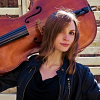Home » Jazz Articles » Album Review » Henry Threadgill: The Other One
Henry Threadgill: The Other One
Much is made of Threadgill's chamber-music esthetic. And rightly so. It is "so chamber music precise it must all be premeditated, right?" asked the critic S. Victor Aaron in a review of another Threadgill album. He answered his own question, beginning the next sentence with "But since it isn't so ...." So, there is the jazz thing, the classical thing with The Other One, the second half of a two set concert recorded live at Roulette Intermedium in Brooklyn in May, 2022. The so-called chamber group is actually a 12-piece ensemble, but, given Threadgill's penchant for arranging, it is like a composite chamber ensemble, different sections taking turns when there isn't someone playing solo, the leader conducting it all.
All music written by Threadgill,The Other One is a three-movement composition entitled "Of Valence," the musical component of a large multimedia work that—as the first performance entitled "One"—also included video, projected paintings and photos, electronics, and more. More including a pre-recorded choir (made up of his own voices) and Threadgill playing the singing pianist.
Dedicated to percussionist Milford Graves, who passed away in 2021, The Other One feels like a recording that could have been made in your home, so intimate are the voices recorded, the live-ness there even before one hears the audience at the end with their applause. There is such an immediacy to the performances that it feels both spontaneous and organized, as if any particular sound heard was being made up on the spot but firmly ensconced in the overall scheme.
The three "Movements" are listed numerically, with "Sections" also listed numerically. It all starts with David Virelles' solo piano setting the stage for what is to follow: a series of alternating partial group segments with more solo work. With Threadgill just conducting and NOT playing any instruments, key moments come from both alto saxophonists Alfredo Colón and Noah Becker (who doubles on clarinet), who are alternately heard playing mournfully as if out on a porch howling at the moon or combining with the string quartet of violinist Sara Caswell, violist Stephanie Griffin, and cellists Mariel Roberts and Christopher Hoffman. There is much friction as well as synchronicity and sound-making from their respective instruments as they veer off from conventional strategies, Craig Weinrib's drumming added to the ensemble's drive and intensity before quietly letting the music settle ... before picking up the pace once again. Weinrib's evocative drumming and electronics help set the stage for this extended exchange between all involved. We also get to hear a familiar voice added with Jose Davila on tuba. Add bassoon players Sara Schoenbeck and Adam Cordero with tenor saxophonist Peyton Pleninger and you have the makings of the most original instrumentation going these days; in this case, a baker's dozen.
"Movement II," in particular, was inspired by Graves' study of the human heart beat and how it applies to music. Fascinatingly so, this movement is played by the string trio (minus Christopher Hoffman) as they "play their parts while listening to a playback of their own heartbeats as recorded previously by a cardiologist." Weinrib's playing is also affected by Graves indirectly with his cymbals hooked up with transducers, something that might be too subtle to hear without knowing why it all sounds so altered and affecting.
With the unpredictable ways Threadgill makes composition and improvisation seamless, the flow of each section allows for much space and personality as each player is woven (and weaves) in and out of that flow. Virelles' presence is striking in that his piano is like a coloristic invocation one moment and a traditional comping band member the next. But his presence, like everyone else's, is selective; so, when we hear his voice it reminds that each instrument's voice is unique, even in those thick counterpoint-ish sections that highlight Threadgill's knack for intervallic and interwoven invention. Toward The Other One's end, in "Movement III," a groove emerges and a kind of rocking swing feel takes over with tuba playing the selective bassist, drummer providing the syncopation and piano adding some kind of honky tonk. But no sooner are we grooving than the string quartet returns with smart and sharp voicings, plucking us back out of that particular dream. Enter Virelles again and it all becomes a tad somber, and then there's the sound of a quizzical bassoon as if answering a mating call.
But we get the idea.
Track Listing
Movement I: Sections 1-2; Section 3; Sections 4-4A; Sections 5-6; Sections 6A-7A; Sections 8-8A; Sections 9-11; Section 11 (Trapset Interlude); Finale; Movement II; Movement III: Section 11A; Sections 12-12B; Section 12B (Violin Interlude); Section 13; Section 14; Section 15; Section 16; Section 17; Finale.
Personnel
Henry Threadgill
woodwindsDavid Virelles
pianoAlfredo Colón
saxophone, altoNoah Becker
saxophone, tenorPeyton Pleninger
saxophone, tenorSara Caswell
violinStephanie Griffin
violaChristopher Hoffman
celloMariel Roberts
celloJose Davila
tubaSara Schoenbeck
bassoonAdam Cordero
saxophone, altoCraig Weinrib
drumsAdditional Instrumentation
Henry Threadgill: conductor; Noah Becker: alto sax, clarinet; Jose Davila: tuba.
Album information
Title: The Other One | Year Released: 2023 | Record Label: Pi Recordings
Comments
About Henry Threadgill
Instrument: Woodwinds
Related Articles | Concerts | Albums | Photos | Similar ToTags
For the Love of Jazz
 All About Jazz has been a pillar of jazz since 1995, championing it as an art form and, more importantly, supporting the musicians who create it. Our enduring commitment has made "AAJ" one of the most culturally important websites of its kind, read by hundreds of thousands of fans, musicians and industry figures every month.
All About Jazz has been a pillar of jazz since 1995, championing it as an art form and, more importantly, supporting the musicians who create it. Our enduring commitment has made "AAJ" one of the most culturally important websites of its kind, read by hundreds of thousands of fans, musicians and industry figures every month.






























